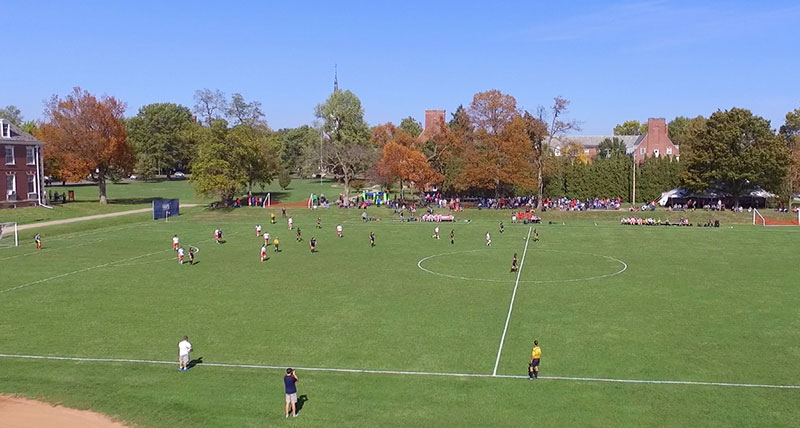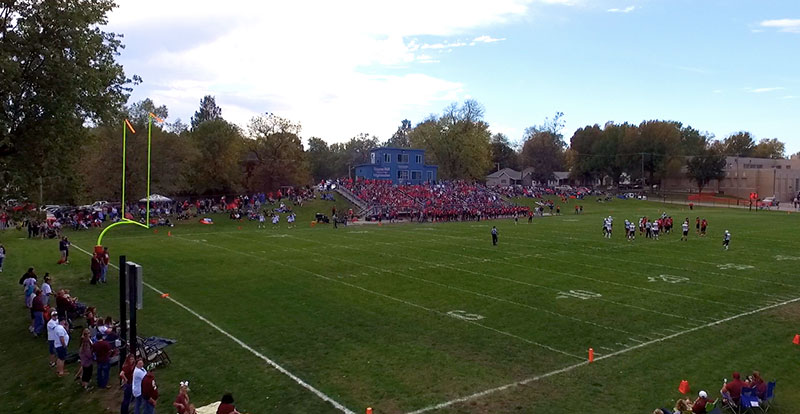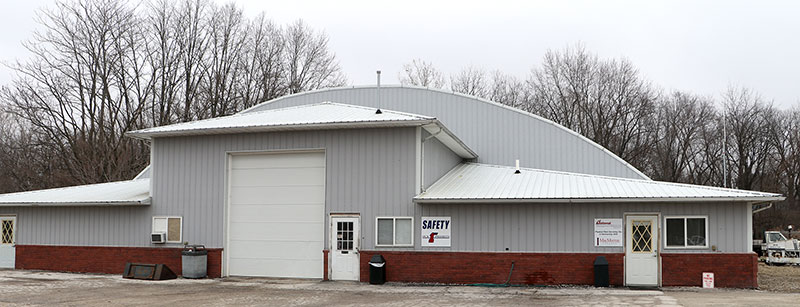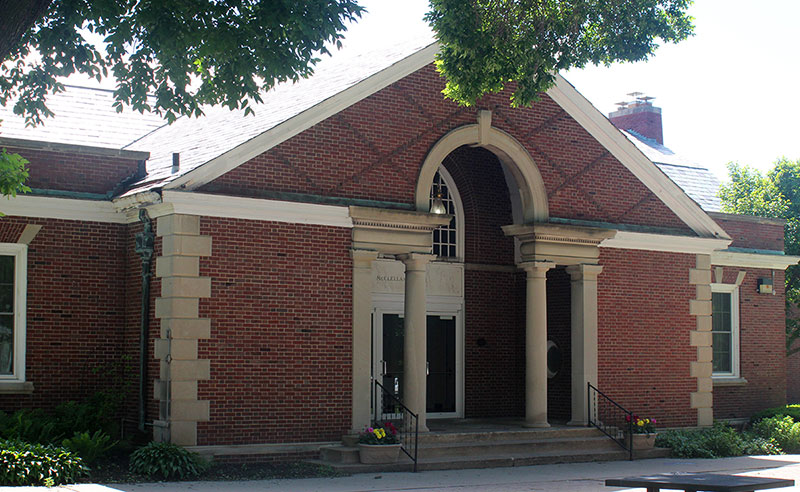Annie Merner Chapel
In 1944, as a way to visibly commemorate the College's Centennial anniversary, the Board of Trustees agreed that the building of a chapel should be part of the Centennial celebration which would take place in October of 1946.
Mrs. Annie Merner Pfeiffer, who had previously donated $100,000 to build the library, agreed to give $125,000 towards the building of a new chapel, but only if friends of the College could raise an additional $75,000 by September 1, 1946 to help pay for the construction. Unfortunately, Mrs. Pfeiffer passed away on January 8, 1946, and it became a challenge for the College and the city of Jacksonville to work together to raise the additional $75,000 needed to build the chapel.
In order to secure Mrs. Pfeiffer's donation, a Citizens Committee endorsed by the Jacksonville Chamber of Commerce was created to raise $50,000 in the community and a call to action was given to the Methodists of the Illinois Conference who eventually contributed more than $100,000 to the chapel fund. The Methodist Board of Education also contributed $25,000. Additional funds were raised by alumni and friends of the College. However, due to WWII and its aftermath, the building of the chapel did not commence until 1948.
The laying of the cornerstone took place on October 8, 1948 and the chapel, named after its generous donor, was dedicated on December 11, 1948. Inspired by Georgian architecture with a red brick exterior and white trim, it became a central location on campus where the college community could come together for worship.
Don Timm Baseball Field
Don Timm Baseball Field, in conjunction with the soccer field, is a uniquely designed dual-purpose athletic facility. It is located in the heart of the MacMurray campus and is the home of Highlander baseball and soccer.
Freesen Football Field
Constructed in 2003, Freesen Field is the official home of Highlander football. The field is located in the southern area of campus and sports a natural grass playing surface, stadium seating for up to 1,000 people on the home side of the field, a press box, and visitor seating for 400.
Freesen Field is named in honor of MacMurray Lifetime Trustee O. Robert "Bob" Freesen and his wife, Deb, who stepped forward to make the dream of a new football field a reality.
Gamble Campus Center
The Gamble Campus Center, finished in 1965, helped to unite the North and South campuses. The building was named after Mrs. Merritt C. Gamble, a donor and trustee of the College, and currently houses the Bookstore, Campus Security, Health Services, the Mail Center, Religious Life, Residence Life, Student Life and Piper's Grill. A central location on campus, Gamble is the helm of student activity where student organizations meet and students hang out to grab a coffee at Highland Grounds and watch a movie, compete in video game tournaments or play a round of pool with their peers.
Located upstairs in Gamble are various meeting rooms as well as the Ann Orr Dance Floor which can seat 350 people. The Dance Floor also has movable partitions that allow for the large area to be divided into conference rooms.
Gordon Facilities Management Building
Henry Pfeiffer Library
Originally housed in the old Main building (razed in 1975), the library was a single room to be used by the students, faculty and staff; however, due to extensive growth at the College between 1928 and 1937, there was a need for a bigger library. President McClelland recognized this need and contacted Mrs. Annie Merner Pfeiffer who agreed to donate $25,000 to the building of a new library. She eventually increased her contribution to $100,000 with the stipulation that the College community worked together to raise $100,000 to match her donation.
At a citizen's dinner in 1938, President McClelland announced the campaign for the library, and by commencement in 1940, the fund reached $280,000. The cornerstone laying ceremony occurred on Founder's Day, October 10, 1940, and after the completion of the building, on May 17, 1941, the faculty, staff and students moved the books from Main to the new library. Traffic officers closed off the streets, and professors and deans carried books in knapsacks and shopping bags. The girls also helped carry arms full of books across campus all the while singing songs such as "I've Been Working on the Railroad" and "Tramp, Tramp, Tramp, the Boys are Marching."
The library, built in a Neo-Classical architecture style with some Georgian Revival elements, was dedicated on May 24, 1941. Dr. Raymond Forman, president of the American Library Association, gave the principal address, "Praises to the Temple of Learning," and Mrs. Annie Merner Pfeiffer was the guest of honor. The library was named after her late husband, Henry Pfeiffer, who passed away in 1939.
The James Jaquess House (President's House)
James Jaquess was MacMurray College's first President. During the Civil War, he was Chaplain of the 6th Illinois Cavalry and later Colonel of the 73rd Illinois Infantry. With Lincoln's permission, he visited the Confederacy in 1863 to talk with leaders of the Methodist Episcopal Church South about ending the war. The following summer, Lincoln sent Jaquess and author James Gilmore to talk with the President of the Confederacy. They publicized Jefferson Davis' declaration, "We are fighting for independence — and that, or extermination, we will have." Lincoln next engaged Jaquess as one of his "private agents." He reported on meetings in Canada between Confederates and anti-war Americans and worked with a Confederate scientist to create a self-extinguishing bomb.
The James Jaquess House is reserved for use by the president of MacMurray College. It was dedicated as a Looking for Lincoln wayside exhibit on November 11, 2009.
Jane Hall
Jane Hall was the first residence hall for senior women and was named after Senator MacMurray's second wife, Jane Areson MacMurray. It was constructed in 1930 with two wings added to the hall in 1939. Dorm rooms are arranged in a suite style with two rooms sharing a connecting bathroom. Today, Jane is a co-educational dorm for juniors and seniors.
Jenkins Education Complex
The Education Complex was completed in 1975 and allowed for the razing of Main Hall. When it was built, the building helped to better unify the campus connecting both North and South campuses. It was renamed Jenkins Education Complex in 2006 after Mary Louise Powell Jenkins, class of 1915, who was a dedicated alumna and generous donor to the College. Jenkins Education Complex is home to the Athletics Department, the Office of Career Services, One-Stop Student Services and the School of Professional Studies.
The Bill Wall gymnasium is located in the Jenkins Education Complex and has a capacity of 1400. The gymnasium is named after MacMurray's "father of men's athletics," who worked at MacMurray from 1957-1975 as an instructor of physical education and coach of four athletic teams, and later as the director of athletics and chairman of the Department of Physical Education.
Julian Hall
Julian Hall was built in 1964 and named after Dr. Percy Lavon Julian, a well-known organic chemistry professor. His wife, Anna Johnson Julian, was a notable sociologist as well as a trustee of the College. Julian is the hub of the biology and chemistry departments. Students taking a biology or chemistry course will often attend their lectures and labs in Julian.
Also located in Julian is the Bailey Auditorium which can seat 400 people. The auditorium was named after Dr. William Fleming Bailey who was the Shonle Professor of Chemistry and Chairman of the MacMurray Chemistry Department from 1933 to 1969.
Kathryn Hall
Kathryn Hall was constructed in 1947 with the first women moving into the dorm in January of 1949. It was the last women's dorm to be built and was named after Senator James E. MacMurray's third wife who also served as President of the Board of Trustees. After Main Hall was demolished in 1975, Kathryn Hall was transformed from a dorm into an administration building.
Kendall House
Kendall House was completed in 1961 and was an all-male dorm added to South campus. The dorm was named after Mrs. Ray Kendall, a former MacMurray trustee and alumna of the class of 1899. Currently, Kendall is a co-educational dorm for underclassmen.
MacMurray Science Hall
Senator James E. MacMurray helped pay for the construction of the Science Hall which was completed in 1928 and named in his honor. On the front of the building, there are three names inscribed on each stone plaque located on the third story between the windows of each wing. The south plaque says Aristotle, Copernicus and Bacon, and the north plaque says Newton, Darwin and Pasteur. The building was dedicated on Commencement Day in 1928 and Jane Addams, the "Mother of Social Work," delivered her speech "Efforts Toward World Peace" at the event.
Today, MacMurray Science Hall is home to the deaf education and interpreting department, the social work program, the psychology department and the physics department as well as the biology labs.
Michalson House
Michalson was the last dorm constructed in 1966 on South campus. Originally a men's dorm, it was named after the College's tenth president, Gordon E. Michalson. The dorm is currently offline.
McClelland Dining Hall
McClelland, or "D-Hall" as students have coined it, was built in 1930 and named after the College's eighth president, Dr. Clarence McClelland, who helped secure the funds needed to build the dining hall. D-hall can seat approximately 450 people and is the main location on campus where students can go to enjoy a meal.
McClelland has two large fireplaces at each end of the hall, and the high arched ceiling has three large chandeliers suspended from the center with six smaller chandeliers running along each side. It is a beautiful and historic piece of MacMurray and Jacksonville history, and has played a significant role in the Jacksonville community for over 35 years as the site for the annual Kiwanis Pancake and Sausage Day event.
Norris House
Norris House opened in 1959 and was named after former MacMurray President, Louis W. Norris.
Palmer Softball Field
Constructed in 2003 as part of a campaign, Palmer Field is the official home of Highlander softball. The field is located in the southern area of campus across from Freesen Field and next to the Jenkins Education Complex. It includes site preparation, dugouts, a scoreboard, a new backstop and fencing, and stadium-quality bleachers located behind the backstop.
Alfred Bradford "Brad" Jensen III, a class of 1974 psychology and philosophy/religion major, made a naming gift for the field in honor of Dr. Richard Palmer, Joseph R. Harker professor emeritus of philosophy, in appreciation of the influence that Dr. Palmer has had on his life and in recognition of Dr. Palmer's support of women's athletics on campus.
Putnam/Springer Center
The Putnam/Springer Center was dedicated in 2002 and initially housed the art and music departments. The building was originally called the Putnam Center for Art, named after Irene Jones Putnam, class of 1931, and William H. Springer Center for Music, named after Lifetime Trustee William Springer. The building was shortened to its current name in 2012, after the nursing department moved to Springer Center when the Norris Education Building closed.
Within the Springer Center is the Thoresen Recital Hall which can seat 110 people and is the location of the College's Bosendorfer piano. It was named after the Thoresen Foundation which helped fund the creation of the hall.
Rutledge Hall
Rutledge Hall is a residential building located on North campus and was completed in 1937. Thanks to a big donation made by Board of Trustees President James MacMurray, this was one of the first buildings built on campus after the Great Depression. The students were given permission to name the building and decided to name it after Ann Rutledge as a tribute to Abraham Lincoln's first love from Salem, which is located 35 miles from Jacksonville. In honor of the first eight presidents of the College, the names Jaquess, Andrus, Short and Adams are inscribed on the south plaque and Demotte, Short, Harker and McClelland are inscribed on the north plaque. It remained an all-women's dorm until Fall of 2009.




















